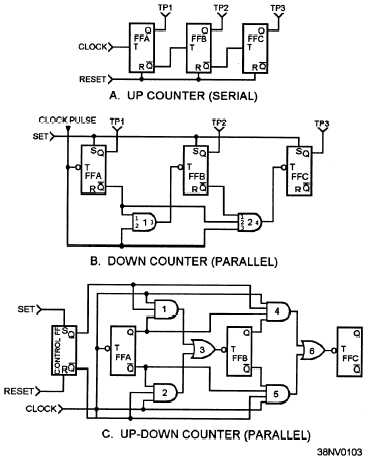specific code after the code has been through the
preliminary circuitry. Figure 4-21 depicts preliminary
translator circuitry.
Memory-Type Functions
Memory-type circuits can store information
derived from previous combinations of inputs. So the
combination of output bits depends not only on the
input signals at the moment, but also on previous com-
binations of bits. These memory-type circuits are called
sequential circuits. This is because the outputs depend
on a sequence, or chain, of inputs at different times. The
sequential logic circuits are made up of combinational
gates and are commonly called flip-flops (FFs). They
provide the control and timing in the computer. Let’s
examine FFs and their uses in computers. The types we
cover are counters and registers.
COUNTERS.— Counters are classified by
function and circuit design. The function classification
refers to how the counter works and is usually the same
as the counter name.
Counters are used to count
operations, quantities, and periods of time; or for
addressing information in storage. As an example, the
program counter keeps track of where the next
instruction is located in memory. Another example is a
ring counter, which is used in the computer’s timing
circuits, where a pulse is output at specific intervals.
The circuit design classification refers to the man-
ner in which the signal being counted affects the flip-
flops in the counter. Counters can be designed for serial
or parallel operations. If the input signal affects the
flip-flops one after another in sequence, it is given the
additional classification of asynchronous serial counter.
When the signal being counted affects the flip-flops at
the same time, it is further classified as a synchronous
parallel counter. Whether a counter is asynchronous or
synchronous will dictate its use in the circuit.
A counter can be designed to count to any power of
2; or a counter can be designed with a modulus. The
modulus of a counter is the maximum number of
numbers or stable combinations the computer can
indicate. You can make a counter with any modulus you
need to fit a particular application. For example, a
binary counter consisting of five orders or stages will
have a modulus of 1000002 (3210) since it has the
capability of registering and/or indicating all binary
numbers from 00000 through 11111.
The three classes of counters (fig. 4-22) are as
follows:
Figure 4-22.—Examples of counters: A. Up counter; B. Down counter; C. Up-down counter.
4-15


